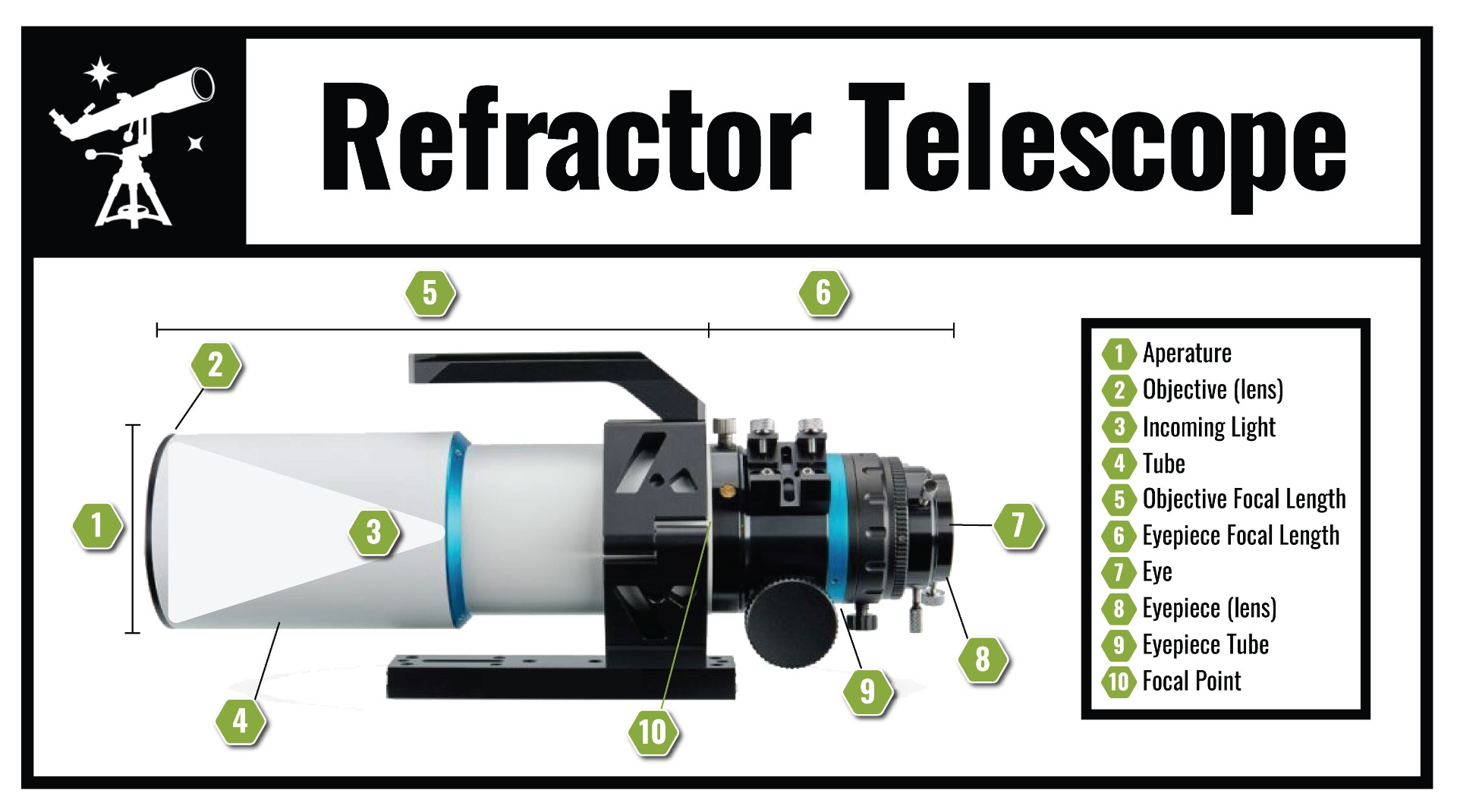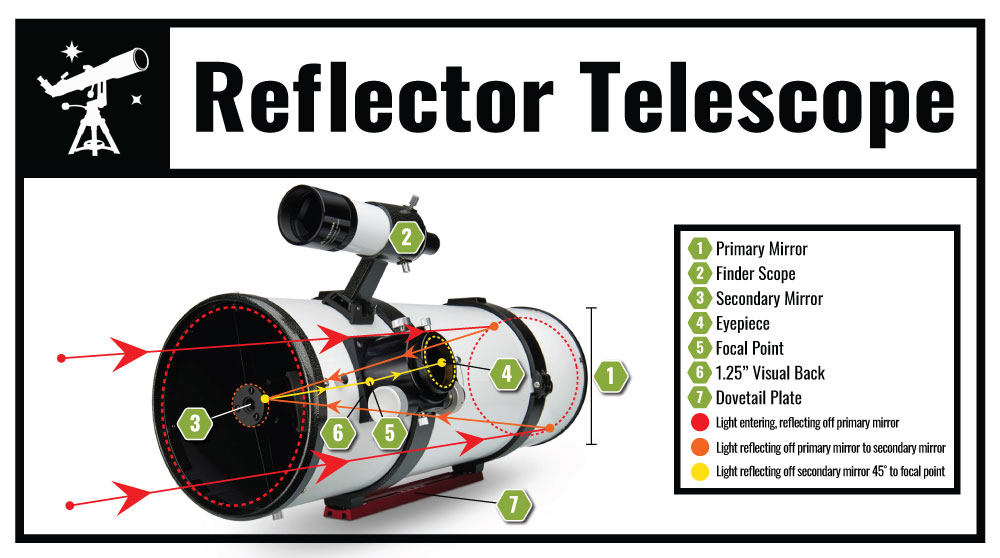
It can be a little confusing trying to learn about telescopes when you’re just starting out in astronomy, and you may be afraid of appearing clueless at your club’s next observing night. Besides the seemingly endless hardware choices, there are a lot of unfamiliar terms you have to learn and understand to get the most out of the hobby. Fortunately, you only need to familiarize yourself with a few to understand the telescopic basics.
Let’s start with a question that’s relatively easy to answer: what are the different types of telescopes? The short answer is that there are two: refractors and reflectors.
What’s a Refractor Telescope?
When many people think of a telescope, they think of someone looking up at the stars through a long tube. These telescopes, known as refractors, were the earliest telescopes to be invented.
At the larger end of the tube is a lens, called an objective lens. The larger the lens, the more light it can gather and the more detail you can see. Light travels down the length of the tube until it reaches the smaller end, where the light exits the telescope through the eyepiece. That’s how the older, simpler refractors worked.
Since it can be uncomfortable trying to observe an object that’s high in the sky, modern refractors use a star diagonal at the small end of the tube. The diagonal contains a small mirror or prism that sends the light up, at a right angle, so the light exits vertically, rather than horizontally.
One end of the diagonal slots into the telescope tube while the other holds the eyepiece. This makes your observing experience a lot more comfortable, as you’re now looking down and into the diagonal and not trying to contort yourself to look up through the tube!
What’s a Reflector Telescope?
Reflector telescopes use a primary and secondary mirror to bring light to a point, rather than lenses. The primary mirror is at the back of the telescope, while the secondary mirror is at the front of the telescope. The aperture, or size of the telescope, is determined by the size of the primary mirror.
Like the objective lens in a refractor, the larger the aperture, the more light is gathered and the more detail you can see.
Light comes into the telescope through the aperture and hits the primary mirror at the bottom of the tube. The mirror then reflects the light up to a smaller, secondary mirror. This acts like a star diagonal in a refractor and reflects the light up and out of the tube via the eyepiece.
However, there’s one type of telescope that’s a hybrid of the two: the catadioptric. This special type of telescope uses both lenses and mirrors to produce a higher-quality image. It does this through the use of a corrector lens or mirror that corrects the errors in the image that can sometimes be produced by lenses or mirrors alone.
As both regular reflectors and catadioptric telescopes use internal mirrors, they’re typically shorter in length. Besides making the telescope easier to transport, this also has an impact for one important reason; it makes it easier to have a longer focal length.
What Is Focal Length and Why Is It Important?
Focal length isn’t actually a component, but it’s a very important number to know. The focal length of a telescope is the distance that light must travel from either the objective lens (on a refractor) or the mirror (on a reflector) to the eyepiece.
This is important because the longer the focal length, the greater the usable magnification of the telescope. With a refractor, light travels from one end of a long tube to the other, so there’s an obvious physical limitation on the focal length. In order to have a longer focal length (and more magnification) you need a longer tube.
A reflector, however, uses mirrors to reflect the light within the tube. As a consequence, it’s possible to have a longer focal length within a shorter tube because the focal length is calculated by the distance light travels within the telescope. Therefore, a reflector has significantly more focal length than typical refractors.
In this way, the light travels through the telescope, hits the main primary mirror, and then travels all the way back up the tube to the secondary mirror and out through the eyepiece. As a result, the light has traveled twice the distance and so the focal length is doubled, too.
How Do You Use the Focal Length to Calculate the Magnification?
So here’s where it gets interesting. You may have seen some telescopes in a department store that boast magnifications of over 1000x. Unfortunately, these claims aren’t credible and these telescopes are rarely little more than toys.
A good beginner’s astronomical telescope needn’t be astronomical in cost. You can buy an excellent telescope, made by a reputable company like Celestron, for less than the cost of a family dinner. And unlike that meal, the enjoyment could last a lifetime.
But how much magnification would it provide? That’s easy to calculate. Telescopes typically come with one or two eyepieces to get you started. They’re usually something like 20mm or 10mm in focal length. In other words, a 20mm eyepiece has a focal length of 20mm - so the light travels 20mm from the open end of the eyepiece to your eye.

Image Source: Johannes Plenio
The magnification is calculated by dividing the focal length of the telescope by the focal length of the eyepiece. For example, the Celestron AstroMaster 90mm Refractor has an objective lens of 90mm and a focal length of 1000mm. It comes with a 10mm and a 20mm eyepiece.
Dividing the telescope’s focal length - 1000 - by the focal length of the eyepiece - say, 20 - will give you a magnification of 50x. This is great for looking at the Moon and star clusters. Dividing 1000 by 10 (the focal length of the smaller eyepiece) gives you a magnification of 100x. That’s great for observing the planets and for splitting double stars.
You Won't See Anything Without This Last Component
None of this matters without one final, key component of the telescope: its focuser. On both a refractor and a reflector, the focuser is where you place the eyepiece. You then turn the knobs on either side to bring your view into focus.
Unfortunately, most of the time you can’t just focus on one object with one eyepiece and then change the eyepiece and expect the view to remain unchanged. You’ll need to refocus with the new eyepiece. When you’re observing the Moon, this isn’t such a problem because it’s an easy object to focus on, but if you’re looking at something faint and fuzzy - like a galaxy - focusing can be a little tricky.
The best way to overcome this is by starting with a low-powered eyepiece and using it to focus on a nearby star. Its light is pretty sharp in comparison to most objects, so once you have that in focus you can increase your magnification, adjust the focus again, and work your way up to a magnification that suits the object you’re observing.
There are other terms you’ll learn when talking telescopes with your astronomy friends. Fortunately, your friends are forgiving and will be more than happy to help you learn more as you dive deeper into the hobby. In the meantime, you now know your focal length from your focuser and you can converse with confidence at your club’s next observing night!

Learn More
Interested in learning more about telescopes and other astronomy gear? Not sure where to begin? Check out our Astronomy Hub to learn more!
This Article was Last Updated on 07/27/2023













